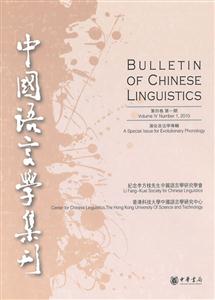-
>
心灵元气社
-
>
县中的孩子 中国县域教育生态
-
>
(精)人类的明天(八品)
-
>
厌女(增订本)
-
>
这样学习才高效/杨慧琴
-
>
心理学经典文丛:女性心理学
-
>
中国文化5000年
第4卷. 第1期-中国语言学集刊 版权信息
- ISBN:9787101072303
- 条形码:9787101072303 ; 978-7-101-07230-3
- 装帧:暂无
- 册数:暂无
- 重量:暂无
- 所属分类:>
第4卷. 第1期-中国语言学集刊 本书特色
《中国语言学集刊(第4卷·第1期)》由中华书局出版的。
第4卷. 第1期-中国语言学集刊 内容简介
本期《中国语言学集刊》受主编余霭芹教授的委托,由我组稿编了一期。文章主要来自“首届演化语言学研讨会暨演化音法学会议”(2009年3月,广州)论文。作为演化音法学的处女论集,这期刊物有它的意义。
第4卷. 第1期-中国语言学集刊 目录
论文
重塑语音学
作为声调区别特征的嘎裂声一一广西八步“八都话”入整公妍
声调演变中的推链与挤压一一粤东客家话原阴上、阴去调交替现象析
长短作为唯一区别——福清方言声调听感实验
北京话两字连读的声调联机规律
潮州话入声的“阴低阳高”
语义虚化与除去口腔阻塞化
益阳方言浊声母的近音化现象咸因分析——兼论汉语方言全
浊声母清化的一种特殊模式
“共同蒙古语”辅音的演变模式
汉藏语中的小舌音问题
红水河壮语长短元音声学分析
元音归一化的方法比较及其应用
纪念李方桂先生中国语言学研究学会董事及执行委员名单
纪念李方桂先生中国语言学研究学会李方桂语言学论著奖申请办法
纪念李方桂先生中国语言学研究学会李方桂语言学论著奖2008—2009
纪念李方桂先生中国语言学研究学会李方桂语言学论著奖历届得奖学者名单
纪念李方桂先生中国语言学研究学会的公开信
纪念李方桂先生中国语言学研究学会赞助人名单
《中国语言学集刊》稿约及撰稿格式
中华书局发行部联系方式
第4卷. 第1期-中国语言学集刊 节选
《中国语言学集刊(第4卷·第1期》受主编余霭芹教授的委托,由我组稿编了一期。文章主要来自“首届演化语言学研讨会暨演化音法学会议”(2009年3月,广州)论文。作为演化音法学的处女论集,这期刊物有它的意义。
第4卷. 第1期-中国语言学集刊 相关资料
插图:Cluster 1 includes variations with relatively low Po max, short D. c. , and short D. v. Vocal folds vibration rarely occurs in Cluster 1. Cluster 2 is composed of variations with relatively high Po max. It has the longest D. c. and D. v. values among the three clusters . Cluster 3 is composed of variations with even higher Po max. Both D. c. andD. v. values are longer than Cluster 1, but shorter than Cluster 2. Figure 8 gives a visual representation of speaker-specific variations corresponding to the three clusters in Table 7. The distinction is represented by three types of Pocurves. These Po curves were drawn with the mean values of the five variables (Po max, Po min, Povibr, D. c. , and D. v. ) of each cluster (shown in Table 7) .Figure 8 illustrates that different strategies are employed to produce the voicelessstop by individual speakers. Speakers in Cluster 2 ( Po curve type 2), such as Speaker ZM, tend to produce long closure duration. Speakers in Cluster 3 (Po curve type 3 ) ,such as speaker YH, prefer to produce high oral pressure. Speaker HY sometimes produces the sound with high oral pressure. For speakers in Cluster 1 (Po curve type 1 ) ,such as speaker JY, the oral pressure is not heightened and the closure duration is not prolonged. It was found that vocal fold vibration (represented by the scratches on the Po line in Figure 8 ) rarely happens in the pronunciations of speakers in Cluster 1. It usually occurs in the pronunciations of the speakers in Clusters 2 and 3, which are either with high oral pressure or with long closure duration.
- >
【精装绘本】画给孩子的中国神话
【精装绘本】画给孩子的中国神话
¥17.6¥55.0 - >
名家带你读鲁迅:朝花夕拾
名家带你读鲁迅:朝花夕拾
¥10.5¥21.0 - >
莉莉和章鱼
莉莉和章鱼
¥16.0¥42.0 - >
李白与唐代文化
李白与唐代文化
¥9.5¥29.8 - >
罗庸西南联大授课录
罗庸西南联大授课录
¥13.8¥32.0 - >
新文学天穹两巨星--鲁迅与胡适/红烛学术丛书(红烛学术丛书)
新文学天穹两巨星--鲁迅与胡适/红烛学术丛书(红烛学术丛书)
¥9.9¥23.0 - >
苦雨斋序跋文-周作人自编集
苦雨斋序跋文-周作人自编集
¥6.9¥16.0 - >
中国历史的瞬间
中国历史的瞬间
¥12.5¥38.0
-
字海探源
¥25¥78 -
《标点符号用法》解读
¥8.3¥15 -
文言津逮
¥10.2¥28 -
那时的大学
¥12¥28 -
现代汉语通用字笔顺规范
¥19.6¥58 -
2020年《咬文嚼字》合订本
¥23.8¥60


















